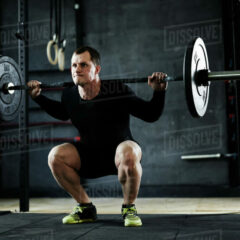Integrating Arm Workouts Into Your Athletic Power Enhancement Plan
Athletic power, a crucial factor in sports performance, combines speed and strength, enabling athletes to produce explosive actions. Sprinters showcase this incredible power by explosively launching off the blocks, and basketball players soar for a spectacular slam dunk. Understanding how arm workouts contribute to this power can significantly enhance athletic performance.
Arm workouts are not just about bulking up; they are about enhancing your overall athletic performance and understanding the three main aspects- strength, endurance, and explosiveness—that can turn good athletes into exceptional ones. Building arm strength can help with lifting and throwing, endurance keeps you going for longer, and explosiveness adds speed to your movements, giving you the power to excel in your sport.The anatomy of the arm is key to targeting the right muscles. We’re talking biceps, triceps, and the muscles of the forearm. Each muscle group serves a vital function in enhancing your athletic prowess. Working these muscles efficiently ensures increased power and better performance on the field or court.

Incorporating arm exercises into a broader workout plan brings numerous benefits. Besides more power, you’ll notice better performance in specific sports actions like throwing a ball or swimming. Stronger arms contribute to overall muscle balance and can help prevent injuries.
There are many misconceptions about arm workouts and athletic power, but one thing is clear: a balanced routine is key. It’s not just about heavy lifting, but a combination of flexible movement exercises and targeted muscle work. This approach ensures all-around growth and peak athletic performance, giving you the confidence that you’re on the right track.
Designing an Effective Arm Workout Regimen
Tailored arm workouts can really up your game, no matter the sport. It’sWhen crafting a regimen, it’s crucial to consider your specific goals, the sport you’re involved in, and your current fitness level. A sprinter’s needs will differ from a swimmer’s, and that’s perfectly fine.
There’s a variety of exercises to keep your workout fresh and compelling. Bicep curls, tricep dips, and forearm curls are just a start. Each exercise targets specific muscles, ensuring a balanced workout that doesn’t overwork any particular group. Mixing in compound movements like push-ups or dumbbell presses can also hit multiple muscles simultaneously, adding efficiency to your routine.
Balancing intensity, frequency, and rest is key. Overworking your muscles can lead to burnout or injury, so finding the right mix of challenging yet manageable workouts is essential. Working out each muscle group two to three times a week with adequate rest will lead to better gains without overstraining.
Power-focused workouts often involve plyometric moves and resistance bands, which are fantastic for boosting explosiveness. These devices trigger your muscles in unique ways that traditional weight training might not, helping to maximize your athletic performance.
To effectively build muscle, it’s vital to embrace the principle of progressive overload. This approach entails slowly raising the weights or resistance used in your exercises over time. This approach encourages muscle growth and strength, pushing your boundaries without overexerting yourself. It’s important to remember that muscle development is a marathon, not a sprint, and that patience and consistency are key to achieving your goals.
In this digital age, you’re not alone in your fitness journey. Productivity apps and virtual coaching tools can track your progress, providing insights and guidance. Whether it’s an app that monitors your heart rate or a virtual trainer suggesting tweaks, technology can be a powerful ally, supporting you in reaching your fitness goals.
Complementing Arm Workouts with a Comprehensive Training Plan
An arm workout can supercharge your athletic performance, but it’s even more effective when integrated into a broader training strategy. Focusing solely on arms without considering the whole body can lead to imbalances and subpar results.
Dynamic warm-ups tailored to arm workouts are essential. They prepare your muscles for heavy lifting, reducing the risk of injury. A good warm-up routine could include light cardio and dynamic stretches that target both arms and the connected muscle groups.
A well-rounded training plan should mix arm exercises with lower-body and core workouts. During most sports activities, your entire body works as a unit, so strengthening everything leads to more powerful and efficient movements.
Cross-training can offer a fresh perspective and improve your overall athletic power. Activities like swimming or even yoga add variety, enhance flexibility, and maintain motivation. It helps keep your training holistic and your body well-prepared for any athletic demands.
Strategizing rest days is as crucial as the workout itself. It’s easy to forget that muscles grow when you’re resting, not lifting. Proper rest ensures maximum gains and reduces the risk of overtraining injuries.
Sprinkling in some cardiovascular exercises boosts endurance and supports your arm training. Activities like running or cycling improve aerobic capacity, which means longer, more effective workouts. Balancing muscle work with cardio can lead to superior performance across all aspects of athleticism.
Achieving Consistency and Overcoming Challenges
Consistency is what separates amateur efforts from real athletic progress. Making arm workouts a regular practice can seem daunting initially, but incorporating them into your routine can quickly become second nature. Scheduling workouts like any other important event can keep you on track.
Many of us face barriers such as a lack of motivation or plateaued progress as we develop our regimen. Shaking things up with new exercises or setting small, achievable goals can reignite the drive. Plus, it’s rewarding to see those small victories build up over time.
Accountability can come from workout partners or online fitness communities. Sharing progress and encouraging each other creates a sense of commitment, making you more likely to stick to your routine even when enthusiasm wanes.
Tracking progress is not only motivating but also crucial for adjusting goals. Whether lifting more weight or nailing those extra reps, each small win counts. These incremental successes are reminders of your journey and the progress made.
Myths about arm workouts can sometimes derail efforts — the idea that more is better or that specific exercises are the secret to strength. Keeping informed and focusing on balanced, varied routines can prevent such misconceptions from undermining your progress.
Seeking professional advice from physical therapists, trainers, or nutritionists can transform your training plan and help you achieve your goals more effectively. Their expertise can help you tailor a program to meet your needs, optimizing your performance and fitness journey.
https://weightliftingforpower.com/intense-great-tricep-workouts/
